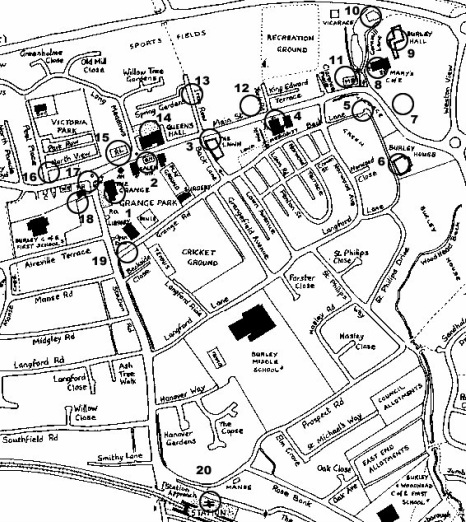The Burley History Trail

_This is a brief outline of the route of the Burley History Trail,
which was created by a small group of young people as part of the Young
Enterprise Scheme. A Booklet giving more information on each of the
sites together with other information about the history of Burley and
the making of the trail can be purchased for £1 from The Corner Shop,
from Open Door and at Community Trust coffee mornings.
Starting at The Grange (1), built by John Peele Clapham and owned as a private residence by different families until early in the 20th century, walk through the park past the Roundhouse to Salem Chapel (2). John Peele Clapham built this in 1840
Starting at The Grange (1), built by John Peele Clapham and owned as a private residence by different families until early in the 20th century, walk through the park past the Roundhouse to Salem Chapel (2). John Peele Clapham built this in 1840
- You are now on Main Street; follow this down to The Lawn (3) built as a private residence in the 1860’s and now converted to provide accommodation for twenty-three single persons
- Walk further down Main Street alongside the open area in front of The Lawn and you come to the Methodist Church (4). This building was dedicated in 1867; the older building alongside it was the previous chapel built in 1816
- Carry on down Main Street to the Village Green (5). Walk across the Village Green towards the roundabout at the entrance to the village and on your right is Burley House (6), built by Thomas Maude in 1798, the only Grade I listed building in Burley
- Cross the road and walk back towards the Church past the row of cottages until you reach an archway with a lamp over it. This is Post Office Yard (7). It gets its name from the fact that the village Post Office was located in this former shop around 1850. Next to the old shop window is a post belonging to the village stocks
- You have now reached St Mary’s Church (8). A chapel has stood on this site since the 15th Century and the church register dates from 1774
_
- Carry on down the lane with the duck pond on your left and you will arrive at the entrance to Burley Hall (9), the third hall to occupy this site. Sir Richard Maunsel paid ‘half a knights fee’ for the first Manor in 1279 and since that time several families have held the title of Lord of the Manor. It is now a Nursing Home and can be seen better from the bypass. Further down the lane you come to the Corn Mill (10) where in 1902 John Clapham set up in business supplying local farmers with animal feed
- Now retrace your steps back up the lane to the junction with Main Street to The Malt Shovel and the Pudding Tree (11). The Malt Shovel originally had a thatched roof. Until 1787 a feast was held each year and a giant pudding was boiled, sold and eaten under the great Elm tree (now replaced by a sapling). Walk back up Main Street past The Malt Shovel towards the centre of the village. Just past The Malt Shovel car park you come to Dial House (12) one of the oldest remaining houses in the village
- Carry on up the Main Street until you reach Iron Row (13) built around 1800 by Greenwood and Whitaker for their mill workers. Looking down this road you can see the old gateposts for the entrance to Greenholme Mills, this was where most of the people of the village worked and the source of employment it created was responsible for a large increase in the population of Burley
- Further up Main Street you come to the Queens Hall (14), formerly the Lecture Hall presented to the village by Forster and Fison when they owned the mill as a place for recreational purposes
- Cross over the entrance to Long Meadows to the Red Lion (15) this was formerly a cottage type Inn and was rebuilt in 1893 by Whitakers Brewery.
- Keep walking on past the cottages with the junction with Station Road on your left and you will come to the entrance to Peel Place (16), William Watson, a poet, was born in Peel Place in 1858
- Cross over the Main Street and walk back towards Station Road (17). This junction used to be the turning point for the Leeds Corporation trolley buses. In 1919 a Victory Celebration Arch was built at the bottom of Station Road to celebrate the end of the First World War
- Go up the little lane between the greengrocers and the butchers to the Parish Rooms. This site has been chosen to represent the Burley Schools (18) as when it became a listed building the application referred to it as The Old Grammar School
- Return to Station Road, cross over, and walk up past the Post Office to Grange Road (19). This road runs parallel to Main Street along the back of the park and is the home of the Burley Cricket Club
- Returning again to Station Road, follow it up the hill, as its name suggests, to the Railway Station (20), opened in 1865. In the early 1900’s there would have been approximately thirteen staff working at the station in two shifts, both passenger and goods trains used the station and there were sidings where the houses at The Robins now stand